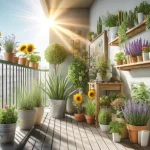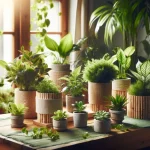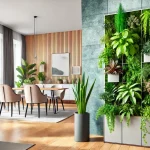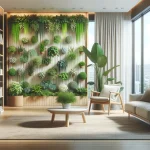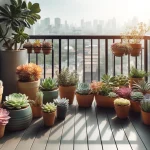This post may contain affiliate links. If you buy something from one of our links we may earn a commission. Thanks
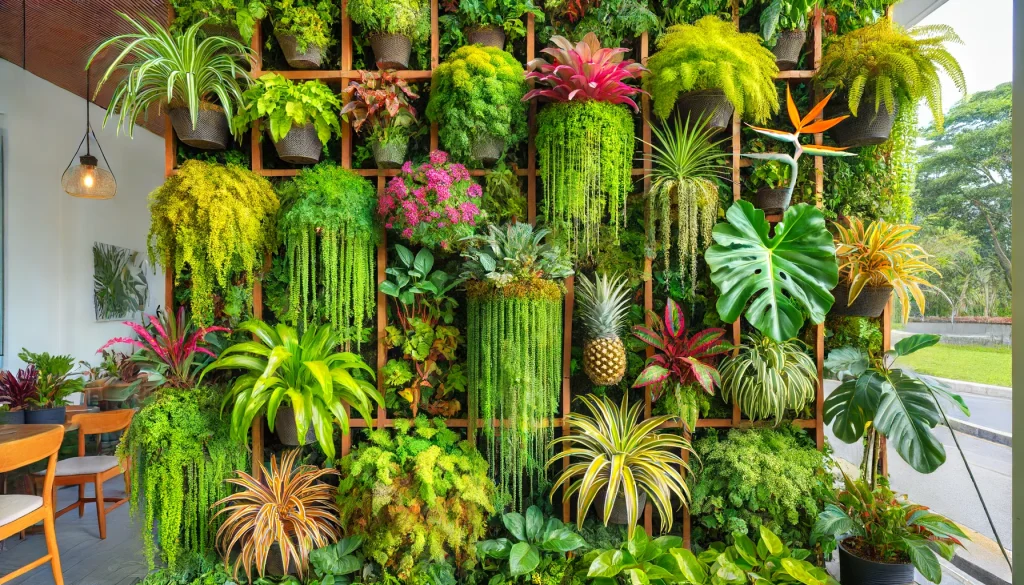
Plant Selection and Placement for Vertical Gardens can make or break your gardening success.
Struggling to choose the right plants? Don’t worry! This guide will show you how to create a thriving vertical garden with ease.
Plant Selection and Placement Key Takeaways
- Plant Selection and Placement for Vertical Gardens involves choosing plants based on light conditions and space.
- Opt for low-light plants like ferns and pothos for shady areas, and bright light plants like succulents for sunny spots.
A True Story About the Importance of Plant Placement
My neighbor Joe is a great guy who likes growing plants. He chose Petunias for his hanging baskets.
They need full sun and his balcony has a North Eastern exposure. He chose the wrong plants for his situation.
So every few days he brings them downstairs where they can get full sun and back to his balcony after a few days.
If he understood about light levels he would have chosen Fushias, Begonias, and Impatiens and had a much easier time.
So while we can’t cover every plant, we have listed a bunch that you can use to guide best plant selection and placement.
Plant Selection and Placement for Vertical Gardens
Choosing the right plants and knowing where to place them is key to a thriving vertical garden. In this guide, I’ll walk you through the best options to make your vertical garden flourish.
Overview of Vertical Gardening and Its Benefits
Vertical gardening is a great way to maximize space, improve air quality, and beautify your surroundings.
It’s perfect for urban dwellers and those with limited outdoor space. Plus, it can reduce the urban heat island effect and boost biodiversity in your area.
Importance of Proper Plant Selection and Placement
Picking the right plants based on their light and space needs is essential. Proper placement ensures each plant gets enough light, water, and nutrients, leading to healthier plants and a more vibrant garden.
I recommend going online and researching the light requirements and cold hardiness of any plant you want to buy before purchasing.
Section 1: Low Light Plants
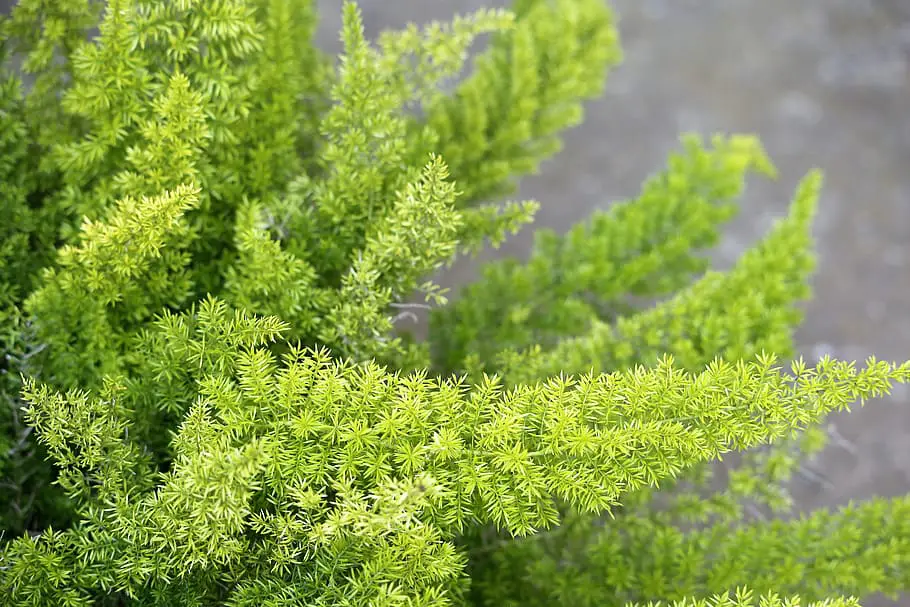
When working with low light conditions, selecting the right plants is crucial for a thriving vertical garden. These plants are perfect for shaded areas and require minimal sunlight to grow.
Ferns
Ferns are ideal for creating lush, green walls in shaded areas. They thrive with minimal light and add a delicate, natural feel to your vertical garden.
Keep the soil moist but not soggy, and mist the leaves occasionally to maintain humidity.
Pothos
Pothos are low-maintenance and perfect for beginners. They grow quickly in low light, making them ideal for indoor gardens.
With their trailing vines, pothos can cover large areas and are very forgiving if you forget to water them occasionally. They can grow in water or soil, making them versatile and easy to manage.
Philodendron
Philodendrons are versatile and easy to grow. They adapt well to low light and add a tropical feel to your garden.
These plants can thrive in various conditions and are perfect for filling vertical spaces with lush greenery.
Bird’s-nest Fern
The bird’s-nest fern adds unique texture with its nest-like rosette of leaves. It thrives in low light and humid conditions, making it perfect for indoor vertical gardens. This fern adds a touch of the exotic to any space.
Nephrolepis
Nephrolepis, or Boston fern, is compact and ideal for small spaces. It prefers low light and consistent moisture, making it a great choice for vertical gardens in shaded areas. Its lush fronds create a beautiful green display.
Baby Tears
Baby Tears are tiny, delicate plants that cover gaps well and thrive in shaded areas. They require regular watering to stay lush and green, making them perfect for adding a soft, carpet-like texture to your vertical garden.
Next, we’ll dive into medium light plants. Ready to keep going?
Section 2: Medium Light Plants
When your vertical garden gets medium light, you have a wide variety of plants to choose from. These plants thrive in conditions with indirect sunlight and add vibrant colors and textures to your garden.
Bromeliaceae
Bromeliads add an exotic flair to your vertical garden with minimal care. These plants are known for their striking, colorful rosettes and can thrive in a variety of light conditions, though they prefer bright, indirect light.
Crotons
Crotons bring bright, colorful foliage that adds visual interest to your garden. They thrive in medium light and are known for their variegated leaves in vibrant shades of red, yellow, and green. These plants need consistent moisture and humidity to maintain their vivid colors.
Fuchsia
Fuchsias are beautiful flowering plants perfect for partial shade. Their dangling, bell-shaped flowers come in various shades of pink, purple, and white, making them a stunning addition to any vertical garden. They prefer cool, moist conditions and need regular watering.
Aeschynanthus
Also known as the lipstick plant, Aeschynanthus has a vining habit and attractive flowers that add a touch of color to your vertical garden. They thrive in medium light and need well-draining soil and consistent watering to produce their vibrant blooms.
Orchids
Orchids are elegant and diverse, making them suitable for vertical setups. They prefer bright, indirect light and high humidity.
Orchids come in a wide variety of colors and patterns, adding a sophisticated touch to your garden.
Tillandsia
Tillandsia, or air plants, require minimal soil and can be placed almost anywhere in your vertical garden.
They absorb nutrients and water through their leaves and thrive in medium light. Simply mist them regularly to keep them healthy.
Anthurium
Anthuriums are known for their striking flowers and foliage. They thrive in medium light and add a bold splash of color to your vertical garden. Keep the soil moist and provide high humidity to help these plants flourish.
Plantain Lilies
Plantain lilies, also known as hostas, are shade-tolerant with attractive leaves. They thrive in medium light and are perfect for adding lush, green foliage to your vertical garden. They prefer well-draining soil and regular watering.
Ready to move on to the next section about bright light plants?
Section 3: Bright Light Plants
Bright light plants are the perfect choice for areas with plenty of sunlight. These plants thrive in sunny spots, bringing vibrant colors and productivity to your vertical garden.
Succulents
Succulents are fantastic for sunny spots. They require minimal water and are incredibly hardy. Their diverse shapes and colors add a unique touch to your vertical garden.
Edible Plants
This category includes various herbs and vegetables that thrive in bright light. Growing your food adds both beauty and functionality to your garden.
Perennial Vines
Perennial vines like Clematis are perfect for covering large vertical spaces. They grow back year after year, providing continuous coverage and beauty.
Strawberry
Strawberries are both delicious and decorative. They produce sweet berries while adding a touch of green to your garden.
Thyme
Thyme is hardy and fragrant, making it a great addition to any garden. It thrives in bright light and can be used in cooking.
Beans
Beans are high-yield and easy to train on vertical structures. They grow quickly and produce a bountiful harvest.
Cucumber
Cucumbers are productive and fast-growing. They climb easily and can be trained to cover vertical spaces efficiently.
Herbs
Various herbs, such as basil, rosemary, and oregano, are well-suited for bright conditions. They are useful in cooking and add a fresh scent to your garden.
Kale
Kale is nutritious and hardy, making it a great addition to a vertical garden. It thrives in bright light and can be harvested continuously.
Morning Glory
Morning glories are fast-growing with beautiful, colorful flowers. They quickly cover vertical structures and add vibrant color.
Vegetables
This broad category includes many options suitable for bright light, such as peppers, carrots, and zucchini. They provide fresh produce right from your garden.
Petunia
Petunias are colorful and easy to grow. They produce abundant blooms and thrive in bright, sunny spots.
Chives
Chives are hardy and useful in cooking. They grow well in bright light and can be harvested repeatedly.
Peas
Peas have a climbing habit and are very productive. They are perfect for vertical gardens and provide a sweet, tasty harvest.
Tomatoes
Tomatoes are a classic vertical garden crop. They need plenty of sunlight and can produce a significant yield.
Cucumbers
Cucumbers are productive and easy to train. They climb well and can produce a large harvest in bright conditions.
Squash
Squash requires support but is highly productive. It grows well in bright light and provides a hearty yield.
Vines
This broad category includes many options, such as grapes and kiwi, which thrive in bright light and can cover large vertical spaces.
Sea Thrift
Sea thrift adds a coastal touch with its flowers. It thrives in sunny conditions and is quite hardy.
Ready to move on to the next section?
Section 4: Plants for Vertical Gardens Outdoor
Outdoor vertical gardens can bring a splash of green to any outdoor space, but choosing the right plants is key.
These plants need to be adaptable and resilient to handle the varying conditions of the outdoors.
Adaptability and Resilience of Outdoor Plants
Outdoor plants must be tough to thrive in a vertical garden. They need to withstand changing weather conditions, from intense sun to heavy rain.
Many plants suited for outdoor vertical gardens are naturally hardy, capable of tolerating a range of temperatures and moisture levels.
For example, succulents are incredibly resilient, thriving in sunny spots with minimal water.
Perennial vines like clematis and wisteria are also great choices because they come back year after year, covering large vertical spaces beautifully.
Another important aspect is the ability to thrive with varying soil conditions. Many outdoor plants, such as thyme and other hardy herbs, can grow well in less-than-ideal soil, which is often a reality in vertical gardening systems.
The root systems of these plants are typically more robust, allowing them to anchor themselves securely in vertical planters.
Specific Needs for Outdoor Vertical Gardens
When setting up an outdoor vertical garden, it’s crucial to consider the specific needs of the plants to ensure they thrive. Here are a few key factors:
Weather Resistance
Outdoor vertical gardens need plants that can handle the elements. This means choosing species that can withstand both heat and cold.
For example, succulents and certain herbs are great for hot, dry climates, while ferns and ivy can handle more shaded and cooler environments.
Sunlight Requirements
Understanding the sunlight patterns in your garden space is vital. Most vegetables and flowering plants need at least six hours of sunlight a day to thrive.
However, some plants, like certain types of ferns, do well in shaded areas. Knowing your garden’s sunlight exposure will help you select the right plants.
For instance, strawberries need full sun to produce a bountiful harvest, while plants like hostas (plantain lilies) can thrive in partial shade.
Watering Needs
Outdoor vertical gardens often require more frequent watering than traditional gardens because the soil volume is limited and can dry out quickly.
Plants like cucumbers and tomatoes need consistent moisture to grow well, so installing a drip irrigation system can be very beneficial.
On the other hand, succulents and some herbs need less water and can tolerate dry conditions better.
Soil and Fertilization
Different plants have varying soil requirements. It’s important to use the right type of soil for the plants you’re growing.
For example, herbs and vegetables typically prefer well-draining soil rich in organic matter. Fertilizing regularly with the appropriate nutrients will also help maintain healthy growth.
By carefully considering these factors and selecting plants that are well-suited to your specific outdoor conditions, you can create a vibrant and resilient vertical garden that will thrive throughout the seasons.
Cold Hardy Perennials vs. Tender Perennials and Annuals
Cold hardy perennials are a solid choice for outdoor vertical gardens, especially in regions with harsh winters.
These plants can survive the cold months and come back each year, reducing the need for replanting.
Examples include hostas and certain types of vining plants like Clemantis and Wisteria.
On the other hand, tender perennials like tomatoes or peppers, and some types of herbs and flowering plants, can’t withstand cold temperatures and might need to be replanted each year or brought indoors during the winter.
Annuals, unlike perennials, complete their life cycle in one growing season. While they need to be replanted each year, they offer vibrant colors and can fill in gaps in your garden quickly.
Examples of good annuals for vertical gardens include petunias and marigolds. Choosing a mix of cold hardy perennials, tender perennials, and annuals can ensure your vertical garden remains vibrant throughout the year.
By carefully considering these factors and selecting plants that are well-suited to your specific outdoor conditions, you can create a vibrant and resilient vertical garden that will thrive throughout the seasons.
Ready to move on to the next section?
Section 5: Plants for Vertical Gardens Indoor
Indoor vertical gardens are a fantastic way to bring greenery into your home without taking up too much space.
They offer a unique aesthetic appeal, transforming blank walls into vibrant, living art pieces.
Plus, they can improve indoor air quality and add a touch of nature to any room.
Aesthetic and Space-Saving Benefits
One of the biggest advantages of indoor vertical gardens is their ability to maximize space.
In apartments or homes with limited floor space, a vertical garden allows you to grow a variety of plants without sacrificing precious real estate.
They also create a striking visual impact, turning plain walls into lush, green displays.
Whether you prefer a minimalist look with a few well-placed plants or a dense, jungle-like wall, vertical gardens can be customized to fit your style and space.
Additional Care Tips for Indoor Environments
Maintaining an indoor vertical garden requires some specific care to ensure your plants thrive. Here are a few key tips:
Humidity
Indoor environments can often be dry, especially in winter. Many plants suitable for vertical gardens, like ferns and philodendrons, thrive in higher humidity.
To maintain adequate humidity, consider using a humidifier, misting your plants regularly, or placing a shallow tray of water near the garden.
Artificial Lighting
Not all indoor spaces have ample natural light, which is essential for most plants.
If your vertical garden is in a dimly lit area, supplementing with artificial lighting is a good idea. LED grow lights are an excellent option as they are energy-efficient and can provide the full spectrum of light needed for plant growth.
Position the lights to cover all areas of your vertical garden evenly.
Watering
Indoor vertical gardens can dry out faster than traditional potted plants due to the limited soil volume. It’s important to keep an eye on moisture levels and water regularly.
Installing a drip irrigation system can help ensure consistent watering, or you can hand-water with a spray bottle to reach all parts of the garden.
Soil and Fertilization
Using the right soil is crucial. A well-draining potting mix is generally best for indoor vertical gardens to prevent waterlogging and root rot.
Regularly fertilize your plants with a balanced, water-soluble fertilizer to provide the necessary nutrients. Follow the instructions on the fertilizer package for the best results.
Temperature
Most indoor plants prefer stable temperatures, typically between 65-75°F (18-24°C).
Avoid placing your vertical garden near drafts, heating vents, or air conditioning units to prevent temperature fluctuations that can stress your plants.
By paying attention to these care tips, you can create a thriving indoor vertical garden that not only saves space but also enhances the aesthetic appeal of your home.
Ready to move on to the next section?
Section 6: Low Maintenance Plants for Vertical Gardens
If you’re a busy gardener or just starting out, low maintenance plants are the way to go.
These plants require minimal care and are perfect for vertical gardens. They can thrive with less attention, making them ideal for those who want a lush garden without the hassle.
Succulents
Succulents are among the easiest plants to care for. They require minimal water and thrive in bright light.
With their thick, fleshy leaves, succulents store water, making them drought-tolerant.
They come in a variety of shapes and sizes, adding interesting textures to your vertical garden.
Pothos
Pothos is perfect for beginners. It’s incredibly hardy and can tolerate low light and irregular watering.
The trailing vines of pothos make it an excellent choice for vertical gardens, as it can cover large areas with lush, green foliage.
Plus, pothos helps purify the air, adding a health benefit to its aesthetic appeal.
Ferns
Ferns, such as the Boston fern, are great for adding lush greenery to shaded areas. They prefer consistent moisture but are otherwise low maintenance.
Ferns add a soft, feathery texture to your vertical garden, creating a tranquil and inviting atmosphere.
Philodendron
Philodendrons are versatile and easy to grow. They adapt well to various light conditions, though they thrive best in indirect light.
These plants are forgiving if you miss a watering or two, making them a reliable choice for busy gardeners. Their large, glossy leaves bring a tropical vibe to any space.
Tillandsia (Air Plants)
Air plants are unique because they don’t require soil to grow. They absorb nutrients and water through their leaves, needing only occasional misting.
These low maintenance plants are perfect for adding a quirky, modern touch to your vertical garden. They thrive in bright, indirect light and are incredibly easy to care for.
Nephrolepis (Boston Fern)
Boston ferns are compact and thrive in low light, making them ideal for indoor vertical gardens.
They need consistent moisture but are otherwise low maintenance. These ferns are great for adding a touch of greenery to darker corners of your home.
Ivy
Ivy is a fantastic low maintenance option for vertical gardens. It’s incredibly hardy and adaptable, thriving in various light conditions from full sun to full shade.
Ivy’s trailing vines make it perfect for covering large vertical spaces quickly. It’s also known for its air-purifying qualities, helping to improve indoor air quality.
Ivy requires regular watering but can tolerate occasional neglect, making it an ideal choice for busy gardeners or those new to plant care.
Choosing low maintenance plants ensures your vertical garden stays beautiful with minimal effort. These plants are perfect for anyone looking to enjoy the benefits of a green space without the constant upkeep.
Ready to move on to the next section?
Section 7: Plants for Vertical Gardens in Pots
Using pots in vertical gardens offers incredible versatility, allowing you to easily rearrange plants and create a dynamic display.
Pots can be hung, stacked, or mounted on vertical structures, making them ideal for both indoor and outdoor gardens.
This flexibility makes it easy to switch out plants as needed, whether for seasonal changes or to replace plants that are not thriving.
Versatility of Using Pots
Pots provide the freedom to experiment with different plant combinations and designs.
You can mix various types of plants, such as succulents, herbs, and flowering plants, to create a visually appealing and functional garden.
Additionally, pots make it simple to control the soil type and moisture levels for each plant, ensuring optimal growth conditions.
This is especially useful if you are growing plants with different needs, as you can tailor the care for each pot individually.
Tips for Selecting the Right Pots
Material Matters
- Choose pots made of durable materials like terracotta, ceramic, or plastic. Terracotta pots are breathable and help prevent root rot but can dry out quickly. Plastic pots retain moisture better but may need more attention to avoid waterlogging.
Size and Shape
- Select pots that are the appropriate size for your plants. Smaller pots are great for herbs and small succulents, while larger pots are better for bigger plants like tomatoes or cucumbers. Ensure the pots are deep enough to support the root systems of your plants.
Weight and Stability
- Consider the weight of the pots, especially if they are to be hung or mounted. Lightweight pots are easier to handle and install but ensure they are stable and won’t tip over easily.
Ensuring Proper Drainage
Proper drainage is essential to prevent waterlogged roots, which can lead to root rot and other issues. Here are some tips to ensure your pots have adequate drainage:
Drainage Holes
- Ensure each pot has at least one drainage hole at the bottom. This allows excess water to escape and prevents the soil from becoming too saturated.
Use Potting Mix or Coco Coir
- Use a well-draining potting mix or coco coir rather than garden soil. Potting mix or coco coir is designed to provide good aeration and drainage, helping to keep your plants healthy.
Elevate the Pots
- Elevate the pots slightly to allow water to drain freely. You can use pot feet, small blocks, or a raised platform to lift the pots off the ground or shelf.
Plants That Do Well in Pots
Herbs
9 Herb Indoor Window Garden Kit
- Basil: Requires full sun and regular watering.
- Parsley: Prefers partial shade and well-draining soil.
- Thyme: Needs full sun and minimal watering.
Vegetables
- Tomatoes: Thrive in large pots with full sun.
- Peppers: Need a warm environment and consistent watering.
- Lettuce: Grows well in cooler temperatures and partial shade.
Flowers
- Petunias: Bloom profusely in full sun.
- Marigolds: Require full sun and are very hardy.
- Begonias: Prefer partial shade and well-draining soil.
Succulents
- Aloe Vera: Needs bright light and minimal watering.
- Echeveria: Thrives in full sun and well-draining soil.
- Jade Plant: Requires bright light and infrequent watering.
Foliage Plants
- Spider Plant: Tolerates low light and irregular watering.
- Snake Plant: Thrives in various light conditions and needs minimal care.

- Ivy: Grows well in both full sun and shade, and requires regular watering.
 By choosing the right pots and ensuring proper drainage, you can create a thriving vertical garden that is both beautiful and functional.
By choosing the right pots and ensuring proper drainage, you can create a thriving vertical garden that is both beautiful and functional.
This approach allows you to enjoy a diverse range of plants while maintaining control over their growing conditions.
Ready to move on to the next section?
Section 8: Evergreen Plants for Vertical Gardens
Evergreen plants are a fantastic choice for vertical gardens, providing year-round greenery and maintaining the visual appeal of your garden even during the colder months.
These plants are not only visually pleasing but also often low-maintenance, making them ideal for busy gardeners.
Benefits of Using Evergreen Plants
Evergreen plants keep their foliage throughout the year, ensuring your vertical garden remains lush and vibrant regardless of the season.
This constant greenery can enhance your garden’s aesthetics, provide a sense of continuity, and improve your outdoor space’s overall ambiance.
Additionally, evergreen plants can help stabilize soil in vertical gardens, reducing erosion and maintaining the structural integrity of your garden setup.
Specific Varieties and Their Care Needs
Bromeliaceae
Bromeliads are perfect for adding an exotic touch to your vertical garden. They thrive in indirect light and need well-draining soil.
Water them by filling the central cup, and ensure the soil stays moist but not waterlogged.
Ferns
Ferns, such as the Boston fern (Nephrolepis), are excellent for shaded areas. They require consistent moisture and high humidity, making them ideal for bathrooms or shaded outdoor spots.
Regular misting and a well-draining potting mix will keep them healthy.
Pothos
Pothos are versatile and can adapt to various light conditions, from low to bright indirect light.
They are drought-tolerant, requiring watering only when the soil is dry to the touch. Pothos are also excellent air purifiers, enhancing indoor air quality.
Crotons
Crotons bring vibrant color to your garden with their brightly variegated leaves. They need bright, indirect light to maintain their vivid colors.
Keep the soil consistently moist and provide high humidity to prevent leaf drop.
Philodendron
Philodendrons are easy to grow and thrive in indirect light. They require moderate watering, allowing the soil to dry out slightly between waterings.
Regular pruning helps maintain their shape and encourages lush growth.
Bird’s-nest Fern
This fern is known for its rosette of broad, green leaves. It thrives in low to medium light and needs high humidity.
Keep the soil consistently moist but not soggy, and avoid direct sunlight to prevent leaf scorch.
Anthurium
Anthuriums are known for their striking red, white, or pink flowers and glossy green leaves. They prefer bright, indirect light and high humidity.
Keep the soil moist but well-drained, and mist the leaves regularly.
Nephrolepis (Boston Fern)
Boston ferns are compact and thrive in low light, making them ideal for indoor vertical gardens.
They need consistent moisture and high humidity. These ferns are great for adding a touch of greenery to darker corners of your home.
By incorporating evergreen plants into your vertical garden, you ensure year-round greenery and vibrant foliage. These plants are not only beautiful but also provide practical benefits, making them a smart choice for any vertical garden.
Ready to move on to the next section?
Section 9: Best Flowering Plants for Vertical Gardens
Flowering plants add a splash of color and beauty to vertical gardens, transforming blank walls into vibrant displays.
These plants not only enhance the aesthetic appeal of your garden but also attract pollinators like bees and butterflies, contributing to the health of your garden ecosystem.
Plants That Add Color and Beauty
Fuchsia
Fuchsia plants are known for their stunning, pendulous flowers in shades of pink, purple, and white.
They thrive in partial shade and require regular watering to keep the soil moist.
Fuchsias bloom from late spring to early fall, adding a long-lasting burst of color to your vertical garden.
Impatiens
Impatiens are ideal for adding vibrant color to shaded vertical gardens. These shade-loving plants bloom in various colors, including pink, red, white, and purple, and thrive in low light conditions.
They require regular watering to keep the soil moist but not waterlogged. Their compact growth habit makes them perfect for filling gaps and creating a lush, colorful display in vertical planters.
Aeschynanthus (Lipstick Plant)
Aeschynanthus, or lipstick plant, has striking red or orange tubular flowers that stand out against its glossy green foliage.
This plant thrives in bright, indirect light and requires well-draining soil. Regular watering and occasional misting will keep it healthy.
The lipstick plant blooms throughout the year, with peak flowering in summer.
Orchids
Orchids are elegant and diverse, making them suitable for vertical setups. They prefer bright, indirect light and high humidity.
Orchids come in a wide variety of colors and patterns, adding a sophisticated touch to your garden.
These plants typically bloom once or twice a year, with flowers lasting several weeks.
Petunia
Petunias are colorful and easy to grow, producing abundant blooms in various shades of pink, purple, red, and white.
They thrive in full sun and require regular watering. Petunias bloom from spring to fall, providing continuous color throughout the growing season.
Morning Glory
Morning glories are fast-growing vines with beautiful, trumpet-shaped flowers in blue, pink, purple, and white. They thrive in full sun and need regular watering.
Morning glories bloom from early summer until the first frost, with each flower lasting only a day but new ones opening daily.
Sea Thrift (Armeria maritima)
Sea thrift adds a coastal touch with its clusters of pink or white flowers atop slender stems. This plant thrives in full sun and well-draining soil.
Sea thrift blooms in late spring to early summer and may have a second, smaller flowering in late summer.
Flowering Cycles and Maintenance Tips
Flowering Cycles
Understanding the flowering cycles of your plants helps you plan a garden that blooms continuously.
Some plants, like petunias and morning glories, provide long-lasting color throughout the growing season.
Others, like orchids, have specific blooming periods but offer stunning displays when they do flower.
Maintenance Tips
- Watering: Most flowering plants need regular watering to thrive. Ensure the soil remains consistently moist but not waterlogged. Overwatering can lead to root rot, while underwatering can cause plants to wilt and flowers to drop.
- Pruning: Regular pruning helps maintain the shape of your plants and encourages more blooms. Remove spent flowers (deadheading) to promote further flowering and prevent the plant from expending energy on seed production.
- Fertilizing: Use a balanced, water-soluble fertilizer to provide essential nutrients. Flowering plants often benefit from a fertilizer high in phosphorus, which supports bloom production.
- Light: Ensure your plants receive the appropriate amount of light. Most flowering plants thrive in full sun to partial shade. Adjust the placement of your vertical garden to optimize light exposure.
By incorporating a variety of flowering plants into your vertical garden, you can enjoy a vibrant, colorful display throughout the year. These plants not only beautify your space but also support a healthy garden ecosystem.
Ready to move on to the next section?
Section 10: Best Vegetables for Vertical Gardening
Vertical gardening is a fantastic way to maximize space and grow a variety of vegetables.
By selecting high-yield, space-efficient vegetable options, you can enjoy a bountiful harvest even in limited areas.
High-Yield, Space-Efficient Vegetable Options
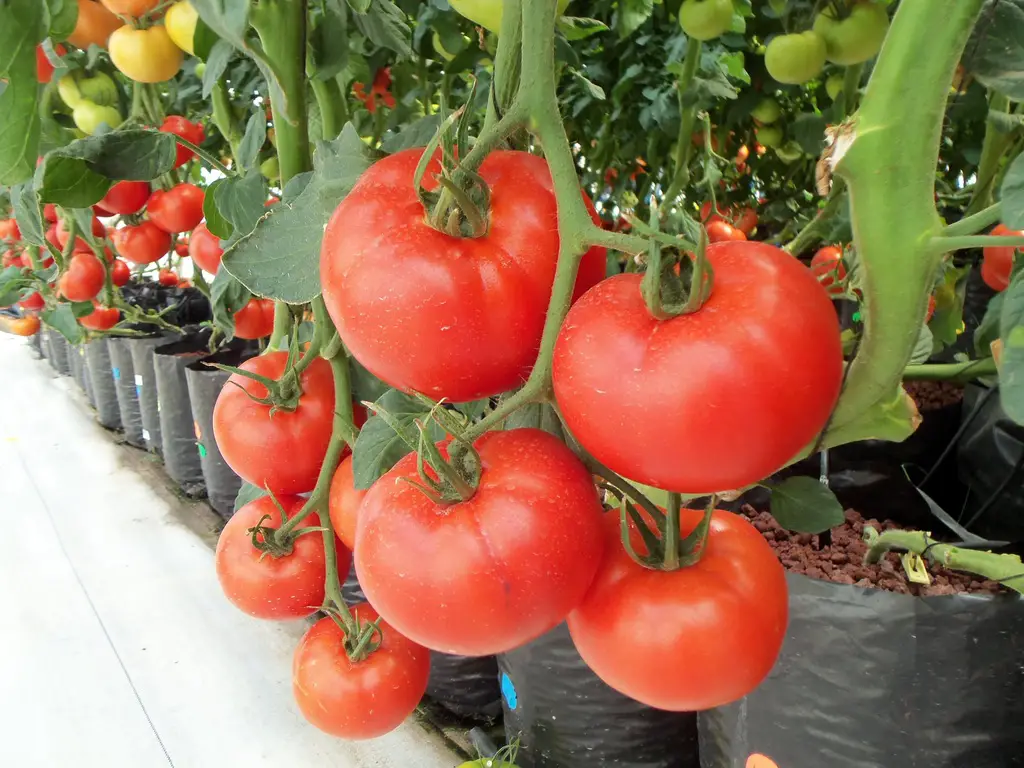
Tomatoes
Tomatoes are a classic choice for vertical gardening. They thrive when trained to grow upwards on trellises or in hanging baskets.
Varieties like cherry or grape tomatoes are particularly well-suited for vertical gardens due to their smaller size and high yield.
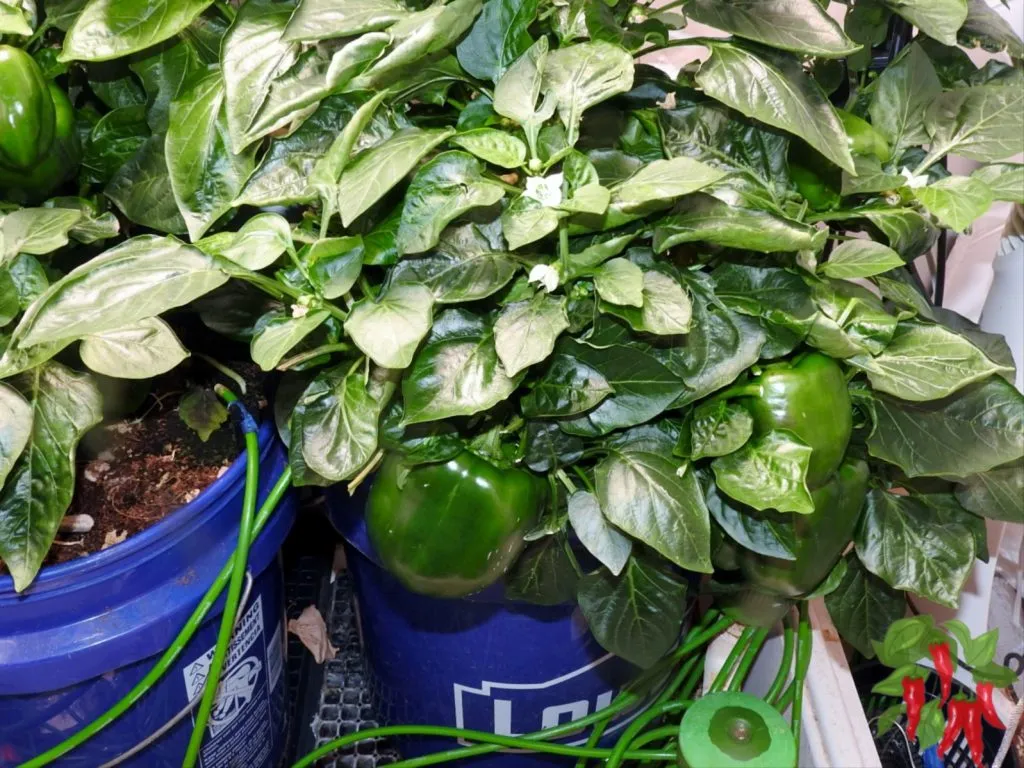
Cucumbers
Cucumbers are productive and fast-growing, making them ideal for vertical spaces. They climb easily with support and produce abundant fruits.
Varieties like ‘Bush Champion’ and ‘Spacemaster’ are compact and perfect for vertical gardening.
Beans
Beans are high-yield and easy to train on vertical structures. Pole beans, in particular, are excellent for vertical gardens as they grow tall and produce plenty of beans over a long period.
Peas
Peas have a climbing habit and are very productive. They are perfect for vertical gardens and provide a sweet, tasty harvest.
Varieties like ‘Sugar Snap’ and ‘Snow Peas’ are ideal for vertical growing.
Lettuce
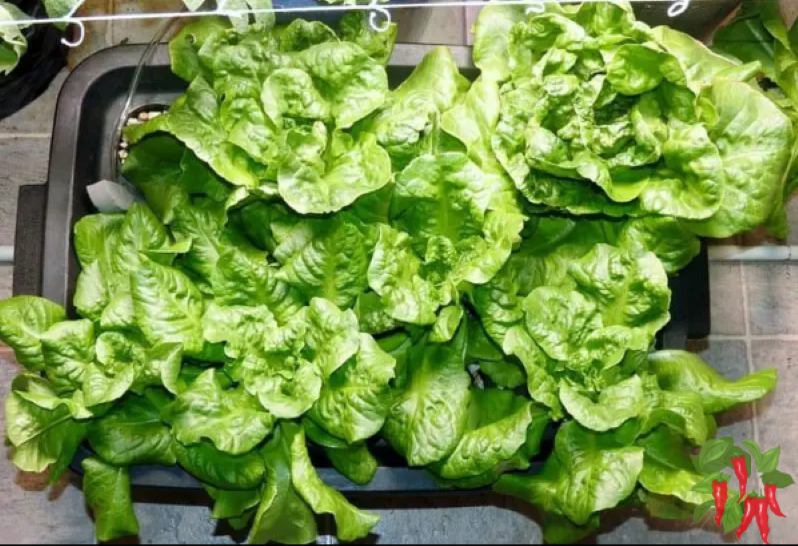
Lettuce grows well in cooler temperatures and partial shade, making it a great choice for vertical gardens.
Leaf lettuce varieties are particularly suited for vertical gardening as they can be harvested continuously.
Kale
Kale is nutritious and hardy, thriving in full sun. It’s perfect for vertical gardens and can be harvested throughout the season. Varieties like ‘Dwarf Blue Curled’ and ‘Lacinato’ are great choices.
Herbs
Herbs such as basil, parsley, and thyme are well-suited for vertical gardens. They need plenty of sunlight and are relatively low maintenance.
Growing herbs vertically not only saves space but also makes it easy to access fresh herbs for cooking.
Tips for Maximizing Production and Healthy Growth
Proper Support Structures
Ensure your vertical garden has sturdy support structures. Trellises, cages, and netting can help guide the growth of climbing plants like beans, cucumbers, and peas.
Secure the structures well to prevent them from tipping over as the plants grow and produce fruit.
Optimal Light and Watering
Most vegetables require at least six hours of sunlight per day. Place your vertical garden in a location that receives adequate sunlight.
Regular watering is essential, as vertical gardens can dry out faster than traditional gardens. Consider installing a drip irrigation system to provide consistent moisture.
Use Quality Soil
Fox Farm Happy Frog Organic Potting Soil
Use a high-quality, well-draining potting mix to ensure your plants receive the nutrients they need.
Regularly add compost or organic fertilizer to maintain soil fertility and support healthy growth.
Pruning and Training
Regularly prune your plants to remove dead or overcrowded branches. Training plants to grow upwards helps improve air circulation and reduces the risk of diseases.
Use ties or clips to secure plants to the support structures as they grow.
Pest and Disease Management
Monitor your plants for signs of pests and diseases. Early detection and treatment are crucial for maintaining healthy plants.
Use natural pest control methods, such as introducing beneficial insects or using neem oil, to keep pests at bay.
Succession Planting
Practice succession planting to ensure a continuous harvest throughout the growing season.
Once a crop is harvested, plant another in its place. This approach maximizes the productivity of your vertical garden.
By selecting the right vegetables and following these tips, you can create a thriving vertical garden that provides a plentiful harvest.
Vertical gardening not only optimizes space but also brings fresh, homegrown vegetables right to your doorstep.
Ready to move on to the next section?
Innovative DIY Vertical Garden Ideas
Creating an eco-friendly vertical garden can be both fun and sustainable by using recycled materials.
Here are some innovative ideas and step-by-step guides to help you get started:
Use of Recycled Materials
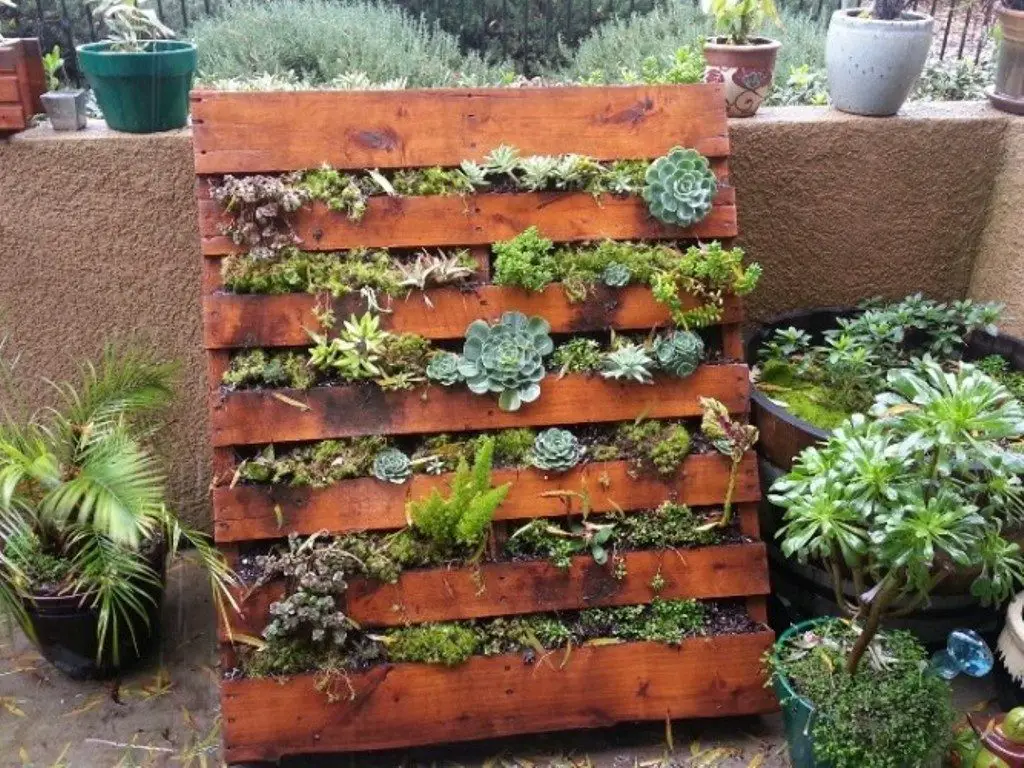
- Pallet Gardens: Old shipping pallets can be repurposed into sturdy frames for vertical gardens. Simply secure the pallet against a wall, line it with landscape fabric to create planting pockets, and fill them with soil and plants.
- Old Containers: Repurpose old tin cans, plastic bottles, or even shoe organizers to create vertical planters. Clean and decorate them, add drainage holes, and mount them on a wall or fence.
Step-by-Step Guide to Building Unique Vertical Garden Structures
- Select Your Materials: Choose sturdy, weather-resistant materials such as pallets, old containers, or wooden crates.
- Prepare the Structure: Clean and, if necessary, paint your materials. Line pallets or crates with landscape fabric to hold soil.
- Install the Structure: Securely mount your structure on a wall or fence. Ensure it is stable and can support the weight of the soil and plants.
- Planting: Fill the pockets or containers with potting mix and add your chosen plants. Ensure you select plants suited to the light conditions of your chosen location.
- Watering and Maintenance: Water the plants thoroughly and set up a regular maintenance routine. Ensure proper drainage to prevent waterlogging.
Advanced Irrigation Solutions
Efficient watering is crucial for the health of a vertical garden. Here are some advanced irrigation solutions:
Drip Irrigation Systems
- Setup: Drip irrigation systems deliver water directly to the roots of plants through a network of tubes and emitters. This minimizes water waste and ensures even watering.
- Benefits: These systems are highly efficient, reduce water usage, and can be automated with timers to ensure plants receive consistent moisture.
Self-Watering Planters
- Design: Self-watering planters have built-in reservoirs that slowly release water into the soil. They are ideal for busy gardeners or those who travel frequently.
- Maintenance: Check and refill the reservoirs regularly to ensure the plants have a continuous water supply.
Tips for Efficient Water Management
- Monitor Soil Moisture: Use soil moisture meters to keep track of water levels and adjust your watering schedule accordingly.
- Mulching: Apply a layer of mulch to the soil surface to retain moisture and reduce evaporation.
Vertical Garden Pest Management
Maintaining a healthy vertical garden involves managing pests effectively. Here are some natural pest control methods and tips:
Natural Pest Control Methods
- Beneficial Insects: Introduce beneficial insects such as ladybugs and predatory beetles that feed on common pests like aphids and spider mites.
- Neem Oil: Use neem oil sprays to deter pests. Neem oil is a natural insecticide that is safe for plants and humans.
Common Pests and How to Address Them
- Aphids: These small, sap-sucking insects can be controlled with a strong spray of water or insecticidal soap.
- Spider Mites: Increase humidity around your plants and use neem oil to control infestations.
- Whiteflies: Sticky traps and insecticidal soaps can help manage whitefly populations.
Seasonal Planting Tips
To keep your vertical garden productive year-round, consider these seasonal planting tips:
Crop Rotation
- Plan Ahead: Rotate crops to different sections of your vertical garden to prevent soil depletion and reduce pest and disease buildup.
- Choose Seasonally Appropriate Plants: Plant cool-season crops like lettuce and spinach in the spring and fall, and warm-season crops like tomatoes and peppers in the summer.
Selecting Plants Based on Seasons
- Spring: Start with leafy greens, herbs, and early vegetables like peas and radishes.
- Summer: Switch to sun-loving plants such as tomatoes, cucumbers, and beans.
- Fall: Plant hardy greens like kale, chard, and late-season root vegetables.
- Winter: Use cold frames or indoor setups for growing herbs and leafy greens.
Creative Design Ideas
Enhance the beauty and functionality of your vertical garden with creative design elements:
Incorporating Art and Lighting
- Decorative Elements: Add artwork, such as colorful tiles or sculptures, to your vertical garden to create a unique focal point.
- Lighting: Use LED grow lights to highlight your plants and provide necessary light for growth. String lights can also add a magical touch to your garden at night.
Privacy Screens and Decorative Focal Points
- Privacy Screens: Use tall, dense plants like bamboo or climbing vines to create natural privacy screens on balconies or patios.
- Focal Points: Design your vertical garden to draw attention to specific areas, such as an entryway or a cozy corner. Use a mix of colorful flowers and interesting foliage to create visual interest.
By exploring these unique angles, you can create a stunning and efficient vertical garden that not only maximizes space but also provides beauty and functionality year-round.
By covering these topics, your blog post will not only provide comprehensive information on plant selection and placement for vertical gardens but also offer unique insights that set it apart from existing content.
Next let’s answer some questions.
FAQ Section: Vertical Gardening
Vertical gardening is becoming increasingly popular for its space-saving benefits and the beauty it adds to small spaces.
Here are some frequently asked questions to help you get started with your vertical garden.
Q: What plants can I grow in a vertical garden?
A: Many plants are suitable for vertical gardens, including vegetables like tomatoes, cucumbers, and beans; herbs such as basil, parsley, and thyme; and flowers like petunias and morning glories.
These plants are well-suited for vertical growing and can thrive in properly set-up vertical gardens.
Q: How do I maintain a vertical garden?
A: Maintaining a vertical garden involves regular watering, checking for pests and diseases, and providing adequate nutrition.
Using a drip irrigation system can help ensure consistent moisture. Additionally, it’s important to prune and train plants to grow vertically and support their growth with trellises or other structures.
Q: What are the benefits of vertical gardening?
A: Vertical gardening maximizes space, reduces pest issues, and can improve air quality. It also makes maintenance easier since plants are at eye level, reducing the need to bend or kneel.
Vertical gardens can also act as natural soundproofing, reducing noise pollution.
Q: How often should I water my vertical garden?
A: Watering needs vary depending on the plant species and the season. Generally, young plants need more frequent watering, and established plants may require watering once or twice a day in hot weather.
Using a soil moisture meter can help you determine when your plants need water.
Q: Can I grow vegetables in a vertical garden?
A: Yes, vegetables such as tomatoes, cucumbers, lettuce, and beans are ideal for vertical gardens.
These plants can be trained to grow upwards, maximizing space and making harvesting easier.
Ensure they receive enough sunlight and water for optimal growth.
Q: What are some good companion plants for vertical gardens?
A: Companion planting can enhance growth and deter pests. For example, basil grows well with tomatoes, and nasturtiums can help divert pests from other plants.
Herbs like parsley and sage can attract beneficial insects and repel harmful ones.
Q: How do I prevent pests and diseases in my vertical garden?
A: To prevent pests and diseases, ensure proper airflow, regularly inspect your plants, and use natural pest control methods like neem oil or introducing beneficial insects.
Maintaining good garden hygiene and avoiding overcrowding can also help reduce the risk of infestations.
By understanding these common questions and answers, you can better manage your vertical garden and enjoy the many benefits it offers.
Conclusion: Thriving Vertical Gardens
Vertical gardening is a creative and efficient way to maximize space and enhance your environment with lush greenery.
By carefully selecting and placing plants, you can create a thriving vertical garden that brings beauty and functionality to your home or outdoor space.
Here’s a recap of the key points covered:
Recap of Key Points
- Plant Selection and Placement Choosing the right plants is crucial for a successful vertical garden. Consider the light, water, and space requirements of each plant to ensure they thrive in their vertical setup.
- Indoor vs. Outdoor Vertical Gardens Indoor vertical gardens benefit from controlled environments and the aesthetic appeal they add to interiors. Outdoor vertical gardens must be resilient to weather conditions and often require more robust support structures.
- Low Maintenance Plants For busy gardeners or beginners, low maintenance plants like succulents, pothos, and ivy are excellent choices. These plants require minimal care and can thrive in various conditions.
- Using Pots in Vertical Gardens Pots offer versatility and ease of rearrangement. Ensure proper drainage and choose the right size and material for your pots to support healthy plant growth.
- Evergreen Plants Evergreen plants provide year-round greenery, maintaining the visual appeal of your garden throughout all seasons. Plants like bromeliads, ferns, and philodendrons are excellent choices.
- Flowering Plants Flowering plants add vibrant colors and attract pollinators. Choose plants that suit your garden’s light conditions and remember to deadhead regularly to promote continuous blooming.
- Vegetables for Vertical Gardening Maximize your space by growing high-yield, space-efficient vegetables like tomatoes, cucumbers, and beans. Proper support and regular maintenance are key to a bountiful harvest.
- Unique Angles and Advanced Tips Explore innovative DIY projects, advanced irrigation solutions, and natural pest management to enhance your vertical garden. Seasonal planting tips and creative design ideas can further optimize your space.
Read more: Indoor Vertical Gardening: Start Your Indoor Garden Now
Final Thoughts
Creating a vertical garden is a rewarding endeavor that combines creativity with practicality.
Whether you’re an experienced gardener or a novice, the principles and tips outlined in this guide will help you build a beautiful, thriving vertical garden.
Embrace the flexibility and diversity that vertical gardening offers, and enjoy the benefits of a green, vibrant space year-round.
Resources for Vertical Gardening
To help you dive deeper into the world of vertical gardening, here are some valuable resources. These non-commercial sites offer a wealth of information on plant care, garden planning, and sustainable practices.
Farmers’ Almanac
The Farmers’ Almanac provides extensive gardening tips, including advice on vertical gardening, planting schedules, and plant care.
University of Florida IFAS Extension
This resource covers everything from establishing and growing plants vertically to creating beautiful and practical garden spaces.
Read more about vertical gardening at UF IFAS Extension
Utah State University Extension
Offers detailed information on vertical gardening techniques, equipment, and plant selection for both school and home gardens.
Learn about vertical gardening at USU Extension
Virginia Tech Extension
Provides comprehensive guides on vertical gardening methods using trellises, stakes, and cages, and their benefits.
Explore vertical gardening techniques at Virginia Tech
Kansas State University Extension
Focuses on the benefits of vertical gardening, including space efficiency and disease prevention, along with practical tips for various crops.
Read about vertical gardening at K-State
Texas A&M AgriLife Extension
A step-by-step guide to building vertical gardens from recycled materials like wooden pallets, perfect for space-saving and creative gardening.
Build a vertical garden with Texas A&M AgriLife
University of California Agriculture and Natural Resources (UC ANR)
Provides insights into creating vertical gardens using various containers and ensuring proper watering and fertilization.
Learn more about vertical gardening at UC ANR
These resources are excellent starting points for anyone looking to expand their knowledge and skills in vertical gardening.
They offer research-backed information and practical tips to help your garden thrive.
Visit my Amazon Influencer Page for videos and gardening products Grow Your Own Garden
















































